California Institute of Technology
The California Institute of Technology (Caltech)[7] is a private research university in Pasadena, California. It was founded as a preparatory and vocational school by Amos G. Throop in 1891 and began attracting influential scientists such as George Ellery Hale, Arthur Amos Noyes and Robert Andrews Millikan in the early 20th century. The vocational and preparatory schools were disbanded and spun off in 1910 and the college assumed its present name in 1920. In 1934, Caltech was elected to the Association of American Universities, and the antecedents of NASA's Jet Propulsion Laboratory, which Caltech continues to manage and operate, were established between 1936 and 1943 under Theodore von Kármán.[8][9] The university is one among a small group of institutes of technology in the United States which is primarily devoted to the instruction of pure and applied sciences.
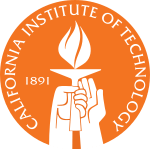 | |
| Motto | The truth shall make you free[2] |
|---|---|
| Type | Private |
| Established | 1891 |
| Endowment | $2.98 billion (2019)[3] |
| President | Thomas F. Rosenbaum |
Academic staff | 300 professorial faculty[4] |
| Students | 2,233 (2018–19) |
| Undergraduates | 948 (2018–19)[5] |
| Postgraduates | 1,285 (2018–19)[5] |
| Location | , , United States 34°08′15″N 118°07′30″W |
| Campus | Suburban, 124-acre (0.2 sq mi; 50.2 ha) |
| Colors | Orange and white[6] |
| Athletics | NCAA Division III – SCIAC |
| Nickname | Beavers |
| Affiliations | |
| Mascot | Orange Beaver |
| Website | www |
Caltech has six academic divisions with strong emphasis on science and engineering, managing $332 million in 2011 in sponsored research.[10] Its 124-acre (50 ha) primary campus is located approximately 11 mi (18 km) northeast of downtown Los Angeles. First-year students are required to live on campus, and 95% of undergraduates remain in the on-campus House System at Caltech. Although Caltech has a strong tradition of practical jokes and pranks,[11] student life is governed by an honor code which allows faculty to assign take-home examinations. The Caltech Beavers compete in 13 intercollegiate sports in the NCAA Division III's Southern California Intercollegiate Athletic Conference (SCIAC).
As of November 2019, Caltech alumni and faculty include 38 Nobel Laureates (39 prizes, with chemist Linus Pauling being the only individual in history to win two unshared prizes), 8 Crafoord Laureates, 1 Fields Medalist, and 6 Turing Award winners. In addition, there are 56 non-emeritus faculty members (as well as many emeritus faculty members) who have been elected to one of the United States National Academies, 4 Chief Scientists of the U.S. Air Force and 71 have won the United States National Medal of Science or Technology.[4] Numerous faculty members are associated with the Howard Hughes Medical Institute as well as NASA.[4] According to a 2015 Pomona College study, Caltech ranked number one in the U.S. for the percentage of its graduates who go on to earn a PhD.[12]
History
Throop College
.jpg)
Caltech started as a vocational school founded in Pasadena in 1891 by local businessman and politician Amos G. Throop. The school was known successively as Throop University, Throop Polytechnic Institute (and Manual Training School)[13] and Throop College of Technology before acquiring its current name in 1920.[10][14] The vocational school was disbanded and the preparatory program was split off to form the independent Polytechnic School in 1907.
At a time when scientific research in the United States was still in its infancy, George Ellery Hale, a solar astronomer from the University of Chicago, founded the Mount Wilson Observatory in 1904. He joined Throop's board of trustees in 1907, and soon began developing it and the whole of Pasadena into a major scientific and cultural destination. He engineered the appointment of James A. B. Scherer, a literary scholar untutored in science but a capable administrator and fund raiser, to Throop's presidency in 1908. Scherer persuaded retired businessman and trustee Charles W. Gates to donate $25,000 in seed money to build Gates Laboratory, the first science building on campus.[15]
World Wars
.jpg)
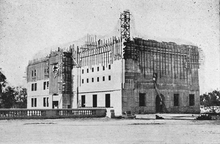
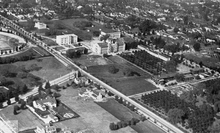
In 1910, Throop moved to its current site. Arthur Fleming donated the land for the permanent campus site. Theodore Roosevelt delivered an address at Throop Institute on March 21, 1911, and he declared:
I want to see institutions like Throop turn out perhaps ninety-nine of every hundred students as men who are to do given pieces of industrial work better than any one else can do them; I want to see those men do the kind of work that is now being done on the Panama Canal and on the great irrigation projects in the interior of this country—and the one-hundredth man I want to see with the kind of cultural scientific training that will make him and his fellows the matrix out of which you can occasionally develop a man like your great astronomer, George Ellery Hale.[16]
In the same year, a bill was introduced in the California Legislature calling for the establishment of a publicly funded "California Institute of Technology", with an initial budget of a million dollars, ten times the budget of Throop at the time. The board of trustees offered to turn Throop over to the state, but the presidents of Stanford University and the University of California successfully lobbied to defeat the bill, which allowed Throop to develop as the only scientific research-oriented education institute in southern California, public or private, until the onset of the World War II necessitated the broader development of research-based science education.[17] The promise of Throop attracted physical chemist Arthur Amos Noyes from MIT to develop the institution and assist in establishing it as a center for science and technology.
With the onset of World War I, Hale organized the National Research Council to coordinate and support scientific work on military problems. While he supported the idea of federal appropriations for science, he took exception to a federal bill that would have funded engineering research at land-grant colleges, and instead sought to raise a $1 million national research fund entirely from private sources. To that end, as Hale wrote in The New York Times:
Throop College of Technology, in Pasadena California has recently afforded a striking illustration of one way in which the Research Council can secure co-operation and advance scientific investigation. This institution, with its able investigators and excellent research laboratories, could be of great service in any broad scheme of cooperation. President Scherer, hearing of the formation of the council, immediately offered to take part in its work, and with this object, he secured within three days an additional research endowment of one hundred thousand dollars.[18]
Through the National Research Council, Hale simultaneously lobbied for science to play a larger role in national affairs, and for Throop to play a national role in science. The new funds were designated for physics research, and ultimately led to the establishment of the Norman Bridge Laboratory, which attracted experimental physicist Robert Andrews Millikan from the University of Chicago in 1917.[19] During the course of the war, Hale, Noyes and Millikan worked together in Washington on the NRC. Subsequently, they continued their partnership in developing Caltech.[18]
Under the leadership of Hale, Noyes, and Millikan (aided by the booming economy of Southern California), Caltech grew to national prominence in the 1920s and concentrated on the development of Roosevelt's "Hundredth Man". On November 29, 1921, the trustees declared it to be the express policy of the institute to pursue scientific research of the greatest importance and at the same time "to continue to conduct thorough courses in engineering and pure science, basing the work of these courses on exceptionally strong instruction in the fundamental sciences of mathematics, physics, and chemistry; broadening and enriching the curriculum by a liberal amount of instruction in such subjects as English, history, and economics; and vitalizing all the work of the Institute by the infusion in generous measure of the spirit of research".[16] In 1923, Millikan was awarded the Nobel Prize in Physics. In 1925, the school established a department of geology and hired William Bennett Munro, then chairman of the division of History, Government, and Economics at Harvard University, to create a division of humanities and social sciences at Caltech. In 1928, a division of biology was established under the leadership of Thomas Hunt Morgan, the most distinguished biologist in the United States at the time, and discoverer of the role of genes and the chromosome in heredity. In 1930, Kerckhoff Marine Laboratory was established in Corona del Mar under the care of Professor George MacGinitie. In 1926, a graduate school of aeronautics was created, which eventually attracted Theodore von Kármán. Kármán later helped create the Jet Propulsion Laboratory, and played an integral part in establishing Caltech as one of the world's centers for rocket science. In 1928, construction of the Palomar Observatory began.
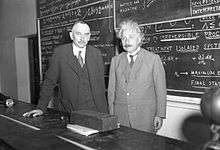
Millikan served as "Chairman of the Executive Council" (effectively Caltech's president) from 1921 to 1945, and his influence was such that the institute was occasionally referred to as "Millikan's School." Millikan initiated a visiting-scholars program soon after joining Caltech. Scientists who accepted his invitation include luminaries such as Paul Dirac, Erwin Schrödinger, Werner Heisenberg, Hendrik Lorentz and Niels Bohr.[20] Albert Einstein arrived on the Caltech campus for the first time in 1931 to polish up his Theory of General Relativity, and he returned to Caltech subsequently as a visiting professor in 1932 and 1933.[21]
During World War II, Caltech was one of 131 colleges and universities nationally that took part in the V-12 Navy College Training Program which offered students a path to a Navy commission.[22] The United States Navy also maintained a naval training school for aeronautical engineering, resident inspectors of ordinance and naval material, and a liaison officer to the National Defense Research Committee on campus.[23]
Project Vista
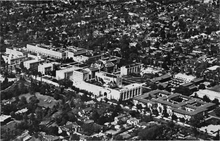
From April to December 1951, Caltech was the host of a federal classified study, Project Vista. The selection of Caltech as host for the project was based on the university's expertise in rocketry and nuclear physics. In response to the war in Korea and the pressure from the Soviet Union, the project was Caltech's way of assisting the federal government in its effort to increase national security.[24] The project was created to study new ways of improving the relationship between tactical air support and ground troops. The Army, Air Force, and Navy sponsored the project, however it was under contract with the Army. The study was named after the hotel, Vista del Arroyo Hotel, which housed the study. The study operated under a committee with the supervision of President Lee A. DuBridge. William A. Fowler, a professor at Caltech, was selected as research director. More than a fourth of Caltech's faculty and a group of outside scientists staffed the project.[25] Moreover, the number increases if one takes into account visiting scientists, military liaisons, secretarial, and security staff. In compensation for its participation, the university received about $750,000.[26]
Post-war growth
From the 1950s to 1970s, Caltech was the home of Murray Gell-Mann and Richard Feynman, whose work was central to the establishment of the Standard Model of particle physics. Feynman was also widely known outside the physics community as an exceptional teacher and colorful, unconventional character.
During Lee A. DuBridge's tenure as Caltech's president (1946–1969), Caltech's faculty doubled and the campus tripled in size. DuBridge, unlike his predecessors, welcomed federal funding of science. New research fields flourished, including chemical biology, planetary science, nuclear astrophysics, and geochemistry. A 200-inch telescope was dedicated on nearby Palomar Mountain in 1948 and remained the world's most powerful optical telescope for over forty years.[27]
Caltech opened its doors to female undergraduates during the presidency of Harold Brown in 1970, and they made up 14% of the entering class.[28] The portion of female undergraduates has been increasing since then.[4]
Protests by Caltech students are rare.[29] The earliest was a 1968 protest outside the NBC Burbank studios, in response to rumors that NBC was to cancel Star Trek. In 1973, the students from Dabney House protested a presidential visit with a sign on the library bearing the simple phrase "Impeach Nixon". The following week, Ross McCollum, president of the National Oil Company, wrote an open letter to Dabney House stating that in light of their actions he had decided not to donate one million dollars to Caltech. The Dabney family, being Republicans, disowned Dabney House after hearing of the protest.[30]
21st century
Since 2000, the Einstein Papers Project has been located at Caltech.[31] The project was established in 1986 to assemble, preserve, translate, and publish papers selected from the literary estate of Albert Einstein and from other collections.
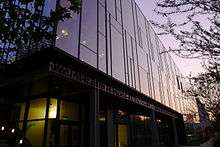
In fall 2008, the freshman class was 42% female, a record for Caltech's undergraduate enrollment.[4] In the same year, the Institute concluded a six-year-long fund-raising campaign. The campaign raised more than $1.4 billion from about 16,000 donors. Nearly half of the funds went into the support of Caltech programs and projects.[32]
In 2010, Caltech, in partnership with Lawrence Berkeley National Laboratory and headed by Professor Nathan Lewis, established a DOE Energy Innovation Hub aimed at developing revolutionary methods to generate fuels directly from sunlight. This hub, the Joint Center for Artificial Photosynthesis, will receive up to $122 million in federal funding over five years.[33]
Since 2012, Caltech began to offer classes through massive open online courses (MOOCs) under Coursera, and from 2013, edX.[34]
Jean-Lou Chameau, the eighth president, announced on February 19, 2013, that he would be stepping down to accept the presidency at King Abdullah University of Science and Technology.[35] Thomas F. Rosenbaum was announced to be the ninth president of Caltech on October 24, 2013, and his term began on July 1, 2014.
In 2019, Caltech received a gift of $750 million for sustainability research from the Resnick family of The Wonderful Company.[36] The gift is the largest ever for environmental sustainability research and the second-largest private donation to a US academic institution (after Bloomberg's gift of $1.8 billion to Johns Hopkins University in 2018).[37]
Campus
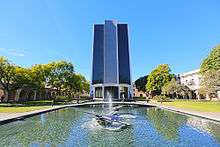
Caltech's 124-acre (50 ha) primary campus is located in Pasadena, California, approximately 11 miles (18 km) northeast of downtown Los Angeles. It is within walking distance of Old Town Pasadena and the Pasadena Playhouse District and therefore the two locations are frequent getaways for Caltech students.
In 1917 Hale hired architect Bertram Goodhue to produce a master plan for the 22 acres (8.9 ha) campus. Goodhue conceived the overall layout of the campus and designed the physics building, Dabney Hall, and several other structures, in which he sought to be consistent with the local climate, the character of the school, and Hale's educational philosophy. Goodhue's designs for Caltech were also influenced by the traditional Spanish mission architecture of Southern California.
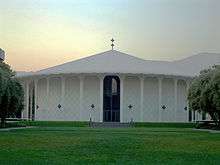
During the 1960s, Caltech underwent considerable expansion, in part due to the philanthropy of alumnus Arnold O. Beckman. In 1953, Beckman was asked to join the Caltech Board of Trustees.[38]:282 In 1964, he became its chairman.[38]:275 Over the next few years, as Caltech's president emeritus David Baltimore describes it, Arnold Beckman and his wife Mabel "shaped the destiny of Caltech".[38]:288
In 1971 a magnitude-6.6 earthquake in San Fernando caused some damage to the Caltech campus. Engineers who evaluated the damage found that two historic buildings dating from the early days of the Institute—Throop Hall and the Goodhue-designed Culbertson Auditorium—had cracked.
New additions to the campus include the Cahill Center for Astronomy and Astrophysics and the Walter and Leonore Annenberg Center for Information Science and Technology, which opened in 2009,[39][40] and the Warren and Katherine Schlinger Laboratory for Chemistry and Chemical Engineering followed in March 2010.[41] The institute also concluded an upgrading of the south houses in 2006. In late 2010, Caltech completed a 1.3 MW solar array projected to produce approximately 1.6 GWh in 2011.[42]
Organization and administration

Caltech is incorporated as a non-profit corporation and is governed by a privately appointed 46-member board of trustees who serve five-year terms of office and retire at the age of 72.[14][43] The current board is chaired by David L. Lee, co-founder of Global Crossing Ltd. The Trustees elect a President to serve as the chief executive officer of the Institute and administer the affairs on the institute on behalf of the board, a Provost who serves as the chief academic officer of the Institute below the President, and ten other vice presidential and other senior positions.[43] Former Georgia Tech provost Jean-Lou Chameau became the eighth president of Caltech on September 1, 2006, replacing David Baltimore who had served since 1997.[44] Chameau's compensation for 2008–2009 totaled $799,472.[45] Chameau served until June 30, 2013. Thomas F. Rosenbaum was announced to be the ninth president of Caltech on October 24, 2013, and his term began on July 1, 2014. Caltech's endowment is governed by a permanent Trustee committee and administered by an Investment Office.
The institute is organized into six primary academic divisions: Biology and Biological Engineering, Chemistry and Chemical Engineering, Engineering and Applied Science, Geological and Planetary Sciences, Humanities and Social Sciences, and Physics, Mathematics, and Astronomy. The voting faculty of Caltech include all professors, instructors, research associates and fellows, and the University Librarian. Faculty are responsible for establishing admission requirements, academic standards, and curricula. The Faculty Board is the faculty's representative body and consists of 18 elected faculty representatives as well as other senior administration officials. Full-time professors are expected to teach classes, conduct research, advise students, and perform administrative work such as serving on committees.[46]
Founded in 1930s, the Jet Propulsion Laboratory (JPL) is a federally funded research and development center (FFRDC) owned by NASA and operated as a division of Caltech through a contract between NASA and Caltech. In 2008, JPL spent over $1.6 billion on research and development and employed over 5,000 project-related and support employees.[47] The JPL Director also serves as a Caltech Vice President and is responsible to the President of the Institute for the management of the laboratory.[48]
Academics
Caltech is a small four-year, highly residential research university with slightly more students in graduate programs than undergraduate.[49] The institute has been accredited by the Western Association of Schools and Colleges since 1949.[50][51] Caltech is on the quarter system:[52] the fall term starts in late September and ends before Christmas, the second term starts after New Years Day and ends in mid-March, and the third term starts in late March or early April and ends in early June.[53]
Rankings
|
|
| ||||||||||||||||||||||||||||||||||||||||||||||||||||||||||||||||||||||||
For 2020, U.S. News & World Report ranked Caltech as tied for 12th in the United States among national universities overall, 8th for most innovative, and 11th for best value.[65] U.S. News & World Report also ranked the graduate programs in chemistry and earth sciences first among national universities.[66]
Caltech was ranked 1st internationally between 2011 and 2016 by the Times Higher Education World University Rankings.[67] Caltech was ranked as the best university in the world in two categories: Engineering & Technology and Physical Sciences.[68][69] It was also found to have the highest faculty citation rate in the world.[70]
Admissions
For the Class of 2023 (enrolled Fall 2019), Caltech received 8,367 applications and accepted 6.4% of applicants; 235 enrolled. The class included 44% women and 56% men. 32% were of underrepresented ancestry, and 6% were foreign students.[71]
Admission to Caltech is extremely rigorous and requires the highest test scores in the nation.[72] The middle 50% range of SAT scores for enrolled freshmen for the class of 2023 were 740–780 for evidence-based reading and writing and 790–800 for math, and 1530–1570 total. The middle 50% range ACT Composite score was 35–36. The SAT Math Level 2 middle 50% range was 800–800. The middle 50% range for the SAT Physics Subject Test was 760–800; SAT Chemistry Subject Test was 760–800; SAT Biology Subject Tests was 760–800[71]
Tuition and financial aid
Undergraduate tuition for the 2013–2014 school year was $39,990 and total annual costs were estimated to be $58,755.[73] In 2012–2013, Caltech awarded $17.1 million in need-based aid, $438k in non-need-based aid, and $2.51 million in self-help support to enrolled undergraduate students. The average financial aid package of all students eligible for aid was $38,756 and students graduated with an average debt of $15,090.[52]
Undergraduate program
The full-time, four-year undergraduate program emphasizes instruction in the arts and sciences and has high graduate coexistence.[49] Caltech offers 24 majors (called "options") and six minors across all six academic divisions.[74] Caltech also offers interdisciplinary programs in Applied Physics, Biochemistry, Bioengineering, Computation and Neural Systems, Control and Dynamical Systems, Environmental Science and Engineering, Geobiology and Astrobiology, Geochemistry, and Planetary Astronomy. The most popular options are Chemical Engineering, Computer Science, Electrical Engineering, Mechanical Engineering and Physics.[75]

Prior to the entering class of 2013, Caltech required students to take a core curriculum of five terms of mathematics, five terms of physics, two terms of chemistry, one term of biology, two terms of lab courses, one term of scientific communication, three terms of physical education, and 12 terms of humanities and social science. Since 2013, only three terms each of mathematics and physics have been required by the institute, with the remaining two terms each required by certain options.[76][77]
A typical class is worth 9 academic units and given the extensive core curriculum requirements in addition to individual options' degree requirements, students need to take an average of 40.5 units per term (more than four classes) in order to graduate in four years. 36 units is the minimum full-time load, 48 units is considered a heavy load, and registrations above 51 units require an overload petition.[78] Approximately 20 percent of students double-major.[79] This is achievable since the humanities and social sciences majors have been designed to be done in conjunction with a science major. Although choosing two options in the same division is discouraged, it is still possible.
First-year students are enrolled in first-term classes based upon results of placement exams in math, physics, chemistry, and writing and take all classes in their first two terms on a Pass/Fail basis.[78] There is little competition; collaboration on homework is encouraged and the honor system encourages take-home tests and flexible homework schedules.[80] Caltech offers co-operative programs with other schools, such as the Pasadena Art Center College of Design and Occidental College.
According to a 2018 PayScale study, Caltech graduates earn a median early career salary of $83,400 and $143,100 mid-career, placing them in the top 5 among graduates of US colleges and universities.[81] The average net return on investment over a period of 20 years is $887,000, the tenth-highest among US colleges.[82]
Caltech offers Army and Air Force ROTC in cooperation with the University of Southern California.[52]
Graduate program
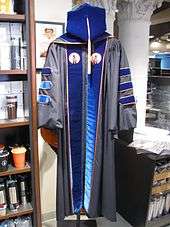
The graduate instructional programs emphasize doctoral studies and are dominated by science, technology, engineering, and mathematics fields.[49] The institute offers graduate degree programs for the Master of Science, Engineer's Degree, Doctor of Philosophy, BS/MS and MD/PhD, with the majority of students in the PhD program.[49] The most popular options are Chemistry, Physics, Biology, Electrical Engineering and Chemical Engineering.[75] Applicants for graduate studies are required to take the GRE. GRE Subject scores are either required or strongly recommended by several options.[83] A joint program between Caltech and the Keck School of Medicine of the University of Southern California, and the UCLA David Geffen School of Medicine grants MD/PhD degrees. Students in this program do their preclinical and clinical work at USC or UCLA, and their PhD work with any member of the Caltech faculty, including the Biology, Chemistry, and Engineering and Applied Sciences Divisions. The MD degree would be from USC or UCLA and the PhD would be awarded from Caltech.[84][85]
The research facilities at Caltech are available to graduate students, but there are opportunities for students to work in facilities of other universities, research centers as well as private industries.[86] The graduate student to faculty ratio is 4:1.[87]
Approximately 99 percent of doctoral students have full financial support. Financial support for graduate students comes in the form of fellowships, research assistantships, teaching assistantships or a combination of fellowship and assistantship support.[88]
Graduate students are bound by the honor code, as are the undergraduates, and the Graduate Honor Council oversees any violations of the code.
Research
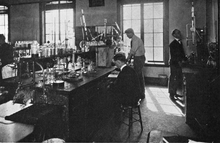
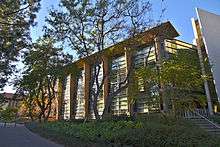
Caltech is classified among "R1: Doctoral Universities – Very High Research Activity".[89] Caltech was elected to the Association of American Universities in 1934 and remains a research university with "very high" research activity, primarily in STEM fields.[8][49] Caltech manages research expenditures of $270 million annually,[90] 66th among all universities in the U.S. and 17th among private institutions without medical schools for 2008.[91][92] The largest federal agencies contributing to research are NASA, National Science Foundation, Department of Health and Human Services, Department of Defense, and Department of Energy.[93] Caltech received $144 million in federal funding for the physical sciences, $40.8 million for the life sciences, $33.5 million for engineering, $14.4 million for environmental sciences, $7.16 million for computer sciences, and $1.97 million for mathematical sciences in 2008.[94]
The institute was awarded an all-time high funding of $357 million in 2009.[95] Active funding from the National Science Foundation Directorate of Mathematical and Physical Science (MPS) for Caltech stands at $343 million as of 2011, the highest for any educational institution in the nation, and higher than the total funds allocated to any state except California and New York.[96]
In 2005, Caltech had 739,000 square feet (68,700 m2) dedicated to research: 330,000 square feet (30,700 m2) to physical sciences, 163,000 square feet (15,100 m2) to engineering, and 160,000 square feet (14,900 m2) to biological sciences.[97]
In addition to managing JPL, Caltech also operates the Palomar Observatory in San Diego County, the Owens Valley Radio Observatory in Bishop, California, the Submillimeter Observatory and W. M. Keck Observatory at the Mauna Kea Observatory, the Laser Interferometer Gravitational-Wave Observatory at Livingston, Louisiana and Richland, Washington, and Kerckhoff Marine Laboratory in Corona del Mar, California.[46] The Institute launched the Kavli Nanoscience Institute at Caltech in 2006,[98] the Keck Institute for Space Studies in 2008, and is also the current home for the Einstein Papers Project. The Spitzer Science Center (SSC), part of the Infrared Processing and Analysis Center located on the Caltech campus, is the data analysis and community support center for NASA's Spitzer Space Telescope.
Caltech partnered with UCLA to establish a Joint Center for Translational Medicine (UCLA-Caltech JCTM), which conducts experimental research into clinical applications, including the diagnosis and treatment of diseases such as cancer.
Caltech operates several TCCON stations as part of an international collaborative effort of measuring greenhouse gases globally. One station is on campus.
.jpg)
Undergraduates at Caltech are also encouraged to participate in research. About 80% of the class of 2010 did research through the annual Summer Undergraduate Research Fellowships (SURF) program at least once during their stay, and many continued during the school year.[99] Students write and submit SURF proposals for research projects in collaboration with professors, and about 70 percent of applicants are awarded SURFs. The program is open to both Caltech and non-Caltech undergraduate students. It serves as preparation for graduate school and helps to explain why Caltech has the highest percentage of alumni who go on to receive a PhD of all the major universities.[100]
The licensing and transferring of technology to the commercial sector is managed by the Office of Technology Transfer (OTT). OTT protects and manages the intellectual property developed by faculty members, students, other researchers, and JPL technologists. Caltech receives more invention disclosures per faculty member than any other university in the nation.[101] As of 2008, 1891 patents were granted to Caltech researchers since 1969.[102]
Student life
House system
During the early 20th century, a Caltech committee visited several universities and decided to transform the undergraduate housing system from fraternities to a house system. Four south houses (or hovses, as styled in the stone engravings) were built: Blacker House, Dabney House, Fleming House and Ricketts House. In the 1960s, three north houses were built: Lloyd House, Page House, and Ruddock House, and during the 1990s, Avery House. The four south houses closed for renovation in 2005 and reopened in 2006. The latest addition to residential life at Caltech is Bechtel Residence, which opened in 2018. It is not affiliated with the house system.[103] All first- and second-year students live on campus in the house system or in the Bechtel Residence.[104]
Athletics

Caltech has athletic teams in baseball, men's and women's basketball, cross country, fencing, men's and women's soccer, swimming and diving, men's and women's tennis, track and field, women's volleyball, and men's and women's water polo.[105] Caltech's mascot is the Beaver, a homage to nature's engineer.[106] Its teams (with the exception of the fencing team) are members of the NCAA Division III and compete in the Southern California Intercollegiate Athletic Conference (SCIAC), which Caltech co-founded in 1915.[107] The fencing team[108] competes in the NCAA's single division in that sport, facing teams from UCLA, USC, UCSD, and Stanford, among others.
On January 6, 2007, the Beavers' men's basketball team snapped a 207-game losing streak to Division III schools, beating Bard College 81–52. It was their first Division III victory since 1996.[109] Until their win over Occidental College on February 22, 2011[110] the team had not won a game in SCIAC play since 1985. Ryan Elmquist's free throw with 3.3 seconds in regulation gave the Beavers the victory.[111][112] The documentary film Quantum Hoops concerns the events of the Beavers' 2005–06 season.
On January 13, 2007, the Caltech women's basketball team snapped a 50-game losing streak, defeating the Pomona-Pitzer Sagehens 55–53. The women's program, which entered the SCIAC in 2002, garnered their first conference win. On the bench as honorary coach for the evening was Dr. Robert Grubbs, 2005 Nobel laureate in Chemistry.[113] The team went on to beat Whittier College on February 10, for its second SCIAC win, and placed its first member on the All Conference team.[114] The 2006–2007 season is the most successful season in the history of the program.
In 2007, 2008, and 2009, the women's table tennis team (a club team) competed in nationals. The women's Ultimate club team, known as "Snatch", has also been very successful in recent years, ranking 44 of over 200 college teams in the Ultimate Player's Association.[115]
On February 2, 2013, the Caltech baseball team ended a 228-game losing streak, the team's first win in nearly 10 years.[116]
The track and field team plays at the South Athletic Field in Tournament Park, the site of the first Rose Bowl Game.
The school also sponsored a football team prior to 1976, which played part of its home schedule at the Rose Bowl, or, as Caltech students put it, "to the largest number of empty seats in the nation".
Performing and visual arts
The Caltech/Occidental College Orchestra is a full seventy-piece orchestra composed of students, faculty, and staff at Caltech and nearby Occidental College. The orchestra gives three pairs of concerts annually, at both Caltech and Occidental College. There are also two Caltech Jazz Bands and a Concert Band, as well as an active chamber music program. For vocal music, Caltech has a mixed-voice Glee Club and the smaller Chamber Singers.[117] The theater program at Caltech is known as TACIT, or Theater Arts at the California Institute of Technology. There are two to three plays organized by TACIT per year, and they were involved in the production of the PHD Movie, released in 2011.
Student life traditions
Annual events
Every Halloween, Dabney House conducts the infamous "Millikan pumpkin-drop experiment" from the top of Millikan Library, the highest point on campus. According to tradition, a claim was once made that the shattering of a pumpkin frozen in liquid nitrogen and dropped from a sufficient height would produce a triboluminescent spark. This yearly event involves a crowd of observers, who try to spot the elusive spark. The title of the event is an oblique reference to the famous Millikan oil-drop experiment which measured e, the elemental unit of electrical charge.
On Ditch Day, the seniors ditch school, leaving behind elaborately designed tasks and traps at the doors of their rooms to prevent underclassmen from entering. Over the years this has evolved to the point where many seniors spend months designing mechanical, electrical, and software obstacles to confound the underclassmen. Each group of seniors designs a "stack" to be solved by a handful of underclassmen. The faculty have been drawn into the event as well, and cancel all classes on Ditch Day so the underclassmen can participate in what has become a highlight of the academic year.
Another long-standing tradition is the playing of Wagner's "Ride of the Valkyries" at 7:00 each morning during finals week with the largest, loudest speakers available. The playing of that piece is not allowed at any other time (except if one happens to be listening to the entire 14 hours and 5 minutes of The Ring Cycle), and any offender is dragged into the showers to be drenched in cold water fully dressed.
Pranks
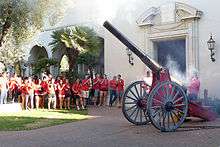
Caltech students have been known for the many pranks (also known as "RFs").[118]
The two most famous in recent history are the changing of the Hollywood Sign to read "Caltech", by judiciously covering up certain parts of the letters, and the changing of the scoreboard to read Caltech 38, MIT 9 during the 1984 Rose Bowl Game. But the most famous of all occurred during the 1961 Rose Bowl Game, where Caltech students altered the flip-cards that were raised by the stadium attendees to display "Caltech", and several other "unintended" messages. This event is now referred to as the Great Rose Bowl Hoax.
In recent years, pranking has been officially encouraged by Tom Mannion, Caltech's Assistant VP for Student Affairs and Campus Life. "The grand old days of pranking have gone away at Caltech, and that's what we are trying to bring back," reported the Boston Globe.[119]
In December 2011, Caltech students went to New York and pulled a prank in Manhattan's Greenwich Village. The prank involved making The Cube sculpture look like the Aperture Science Weighted Companion Cube from the video game Portal.[120]
Caltech pranks have been documented in three Legends of Caltech books, the most recent of which was edited by alumni Autumn Looijen '99 and Mason Porter '98 and published in May 2007.
Rivalry with MIT
In 2005, a group of Caltech students pulled a string of pranks during MIT's Campus Preview Weekend for admitted students. These include covering up the word Massachusetts in the "Massachusetts Institute of Technology" engraving on the main building façade with a banner so that it read "That Other Institute of Technology". A group of MIT hackers responded by altering the banner so that the inscription read "The Only Institute of Technology." Caltech students also passed out T-shirts to MIT's incoming freshman class that had MIT written on the front and "... because not everyone can go to Caltech" along with an image of a palm tree on the back.
MIT retaliated in April 2006, when students posing as the Howe & Ser (Howitzer) Moving Company stole the 130-year-old, 1.7-ton Fleming House cannon and moved it over 3000 miles to their campus in Cambridge, Massachusetts for their 2006 Campus Preview Weekend, repeating a similar prank performed by nearby Harvey Mudd College in 1986. Thirty members of Fleming House traveled to MIT and reclaimed their cannon on April 10, 2006.
On April 13, 2007 (Friday the 13th), a group of students from The California Tech, Caltech's campus newspaper, arrived and distributed fake copies of The Tech, MIT's campus newspaper, while prospective students were visiting for their Campus Preview Weekend. Articles included "MIT Invents the Interweb", "Architects Deem Campus 'Unfortunate'", and "Infinite Corridor Not Actually Infinite".
In December 2009, some Caltech students declared that MIT had been sold and had become the Caltech East campus. A "sold" banner was hung on front of the MIT dome building and a "Welcome to Caltech East: School of the Humanities" banner over the Massachusetts Avenue Entrance. Newspapers and T-shirts were distributed, and door labels and fliers in the infinite corridor were put up in accordance with the "curriculum change."[121][122]
In September 2010, MIT students attempted to put a TARDIS, the time machine from the BBC's Doctor Who, onto a roof. Caught in midact, the prank was aborted. In January 2011, Caltech students in conjunction with MIT students helped put the TARDIS on top of Baxter.[123] Caltech students then moved the TARDIS to UC Berkeley[124] and Stanford.[125]
In April 2014, during MIT's Campus Preview Weekend, a group of Caltech students handed out mugs emblazoned with the MIT logo on the front and the words "The Institute of Technology" on the back. When heated, the mugs turn orange, display a palm tree, and read "Caltech The Hotter Institute of Technology." Identical mugs continue to be sold at the Caltech campus store.[126]
Honor code
Life in the Caltech community is governed by the honor code, which simply states: "No member of the Caltech community shall take unfair advantage of any other member of the Caltech community." This is enforced by a Board of Control, which consists of undergraduate students,[127] and by a similar body at the graduate level, called the Graduate Honor Council.[128]
The honor code aims at promoting an atmosphere of respect and trust that allows Caltech students to enjoy privileges that make for a more relaxed atmosphere. For example, the honor code allows professors to make the majority of exams as take-home, allowing students to take them on their own schedule and in their preferred environment.
Through the late 1990s, the only exception to the honor code, implemented earlier in the decade in response to changes in federal regulations, concerned the sexual harassment policy. Today, there are myriad exceptions to the honor code in the form of new Institute policies such as the fire policy and alcohol policy. Although both policies are presented in the Honor System Handbook given to new members of the Caltech community, some undergraduates regard them as a slight against the honor code and the implicit trust and respect it represents within the community.[129] In recent years, the Student Affairs Office has also taken up pursuing investigations independently of the Board of Control and Conduct Review Committee, an implicit violation of both the honor code and written disciplinary policy that has contributed to further erosion of trust between some parts of the undergraduate community and the administration.[130]
People
As of October 2019, Caltech has 38 Nobel laureates to its name awarded to 22 alumni, which includes 5 Caltech professors who are also alumni (Carl D. Anderson, Linus Pauling, William A. Fowler, Edward B. Lewis, and Kip Thorne), and 15 non-alumni professors. The total number of Nobel Prizes is 39 because Pauling received prizes in both Chemistry and Peace. The official Nobel Prize count is 48 affiliates in total when including temporary academic staff such as visiting professors and postdoctoral scholars. Eight faculty and alumni have received a Crafoord Prize from the Royal Swedish Academy of Sciences, while 58 have been awarded the U.S. National Medal of Science, and 11 have received the National Medal of Technology.[4] One alumnus, Stanislav Smirnov, won the Fields Medal in 2010. Other distinguished researchers have been affiliated with Caltech as postdoctoral scholars (for example, Barbara McClintock, James D. Watson, Sheldon Glashow and John Gurdon) or visiting professors (for example, Albert Einstein, Stephen Hawking and Edward Witten).
Students
| Undergraduate | Graduate | |
|---|---|---|
| White American | 27% | 32% |
| Asian American | 37% | 10% |
| Underrepresented minority | 23% | 6% |
| International | 8% | 47% |
| Two or more races / Unknown | 5% | 4% |
Caltech enrolled 938 undergraduate students and 1,299 graduate students for the 2019–2020 school year. Women made up 45% of the undergraduate and 31% of the graduate student body.[5] The racial demographics of the school substantially differ from those of the nation as a whole.[131]
The four-year graduation rate is 79% and the six-year rate is 92%,[52] which is low compared to most leading U.S. universities,[132] but substantially higher than it was in the 1960s and 1970s.[133] Students majoring in STEM fields traditionally have graduation rates below 70%.[134]
Alumni
There are 22,930 total living alumni in the U.S. and around the world.[135] As of October 2019, twenty-two alumni and 15 non-alumni faculty have won the Nobel Prize. The Turing Award, the "Nobel Prize of Computer Science", has been awarded to six alumni, and one has won the Fields Medal.[136]
Many alumni have participated in scientific research. Some have concentrated their studies on the very small universe of atoms and molecules. Nobel laureate Carl D. Anderson (BS 1927, PhD 1930) proved the existence of positrons and muons, Nobel laureate Edwin McMillan (BS 1928, MS 1929) synthesized the first transuranium element, Nobel laureate Leo James Rainwater (BS 1939) investigated the non-spherical shapes of atomic nuclei, and Nobel laureate Douglas D. Osheroff (BS 1967) studied the superfluid nature of helium-3. Donald Knuth (PhD 1963), the "father" of the analysis of algorithms, wrote The Art of Computer Programming and created the TeX computer typesetting system, which is commonly used in the scientific community. Bruce Reznick (BS 1973) is a mathematician noted for his contributions to number theory and the combinatorial-algebraic-analytic investigations of polynomials. Narendra Karmarkar (MS 1979) is known for the interior point method, a polynomial algorithm for linear programming known as Karmarkar's algorithm.

Other alumni have turned their gaze to the universe. C. Gordon Fullerton (BS 1957, MS 1958) piloted the third Space Shuttle mission. Astronaut (and later, United States Senator) Harrison Schmitt (BS 1957) was the only geologist to have ever walked on the surface of the moon.[137] Astronomer Eugene Merle Shoemaker (BS 1947, MS 1948) co-discovered Comet Shoemaker-Levy 9 (a comet which crashed into the planet Jupiter) and was the first person buried on the moon (by having his ashes crashed into the moon).[138] Astronomer George O. Abell (BS 1951, MS 1952, PhD 1957) while a grad student at Caltech participated in the National Geographic Society-Palomar Sky Survey. This ultimately resulted in the publication of the Abell Catalogue of Clusters of Galaxies, the definitive work in the field.[139]
Undergraduate alumni founded, or co-founded, companies such as LCD manufacturer Varitronix,[140] Hotmail,[141] Compaq,[142] and MathWorks (which created Matlab),[143] while graduate students founded, or co-founded, companies such as Intel,[144] TRW,[145] and the non-profit educational organization, the Exploratorium.[146]
Arnold Beckman (PhD 1928) invented the pH meter and commercialized it with the founding of Beckman Instruments. His success with that company enabled him to provide seed funding for William Shockley (BS 1932), who had co-invented semiconductor transistors and wanted to commercialize them. Shockley became the founding Director of the Shockley Semiconductor Laboratory division of Beckman Instruments.[147] Shockley had previously worked at Bell Labs, whose first president was another alumnus, Frank Jewett (BS 1898). Because his aging mother lived in Palo Alto, California, Shockley established his laboratory near her in Mountain View, California.[147][148] Shockley was a co-recipient of the Nobel Prize in physics in 1956, but his aggressive management style and odd personality[149] at the Shockley Lab became unbearable.[150] In late 1957, eight of his researchers resigned and with support from Sherman Fairchild formed Fairchild Semiconductor. Among the "traitorous eight" was Gordon E. Moore (PhD 1954), who later left Fairchild to co-found Intel. Other offspring companies of Fairchild Semiconductor include National Semiconductor and Advanced Micro Devices, which in turn spawned more technology companies in the area. Shockley's decision to use silicon instead of germanium as the semiconductor material, coupled with the abundance of silicon semiconductor related companies in the area, gave rise to the term "Silicon Valley"[151] to describe that geographic region surrounding Palo Alto.
Caltech alumni also held public offices, with Mustafa A.G. Abushagur (PhD 1984) the Deputy Prime Minister of Libya and Prime Minister-Elect of Libya, James Fletcher (PhD 1948) the 4th and 7th Administrator of NASA, Steven Koonin (PhD 1972) the Undersecretary of Energy for Science, and Regina Dugan (PhD 1993) the 19th director of DARPA. The 20th director for DARPA, Arati Prabhakar, is also a Caltech alumna (PhD 1984). Arvind Virmani is a former Chief Economic Adviser to the Government of India. In 2013, President Obama announced the nomination of France Cordova (PhD 1979) as the director of the National Science Foundation and Ellen Williams (PhD 1982) as the director for ARPA-E.[152]
- Notable Caltech alumni include:

 Nobel laureate Douglas D. Osheroff, BS 1967
Nobel laureate Douglas D. Osheroff, BS 1967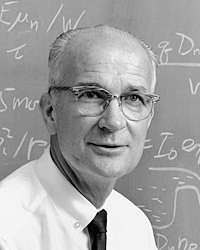 Nobel laureate William Shockley, BS 1932, co-inventor of the solid state transistor, father of Silicon Valley
Nobel laureate William Shockley, BS 1932, co-inventor of the solid state transistor, father of Silicon Valley Nobel laureate Edwin McMillan, BS 1928, MS 1929
Nobel laureate Edwin McMillan, BS 1928, MS 1929 Nobel laureate Vernon Smith, BS 1949
Nobel laureate Vernon Smith, BS 1949 Turing Award laureate Fernando J. Corbató, BS 1950
Turing Award laureate Fernando J. Corbató, BS 1950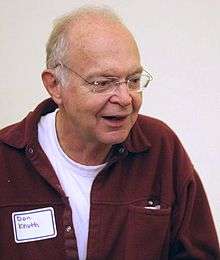 Turing Award laureate Donald Knuth, PhD 1963, "father" of the analysis of algorithms, creator of TeX typesetting system
Turing Award laureate Donald Knuth, PhD 1963, "father" of the analysis of algorithms, creator of TeX typesetting system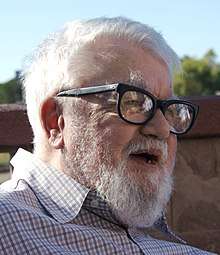 Turing Award laureate John McCarthy, BS 1948, inventor of the Lisp programming language
Turing Award laureate John McCarthy, BS 1948, inventor of the Lisp programming language Astronaut C. Gordon Fullerton, BS 1957, MS 1958
Astronaut C. Gordon Fullerton, BS 1957, MS 1958 Astronaut and United States Senator Harrison Schmitt, BS 1957, the only geologist to have walked on the moon
Astronaut and United States Senator Harrison Schmitt, BS 1957, the only geologist to have walked on the moon- Libyan Deputy Prime Minister & Libyan Prime Minister-Elect Mustafa A.G. Abushagur, PhD 1984
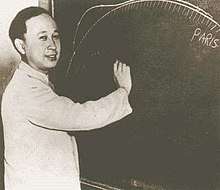 Qian Xuesen, PhD 1939, co-founder of JPL, "Father" of Chinese rocketry
Qian Xuesen, PhD 1939, co-founder of JPL, "Father" of Chinese rocketry Arnold Orville Beckman, PhD 1928, inventor of the pH meter, founder of Beckman Instruments and the Arnold and Mabel Beckman Foundation
Arnold Orville Beckman, PhD 1928, inventor of the pH meter, founder of Beckman Instruments and the Arnold and Mabel Beckman Foundation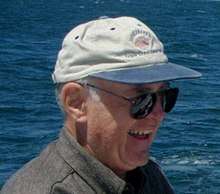 Gordon Moore, PhD 1954, co-founder of Intel
Gordon Moore, PhD 1954, co-founder of Intel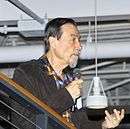 National Medal of Technology laureate Carver Mead, BS 1956, MS 1957, PhD 1960
National Medal of Technology laureate Carver Mead, BS 1956, MS 1957, PhD 1960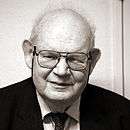 Benoit Mandelbrot, MS 1948, Engineering 1949, father of fractal geometry, namesake of the Mandelbrot set
Benoit Mandelbrot, MS 1948, Engineering 1949, father of fractal geometry, namesake of the Mandelbrot set.jpg)
- Frank Capra, BS Chemical Engineering 1918 (when Caltech was known as the "Throop Institute");[153] winner of six Academy Awards in directing and producing; producer and director of It's a Wonderful Life
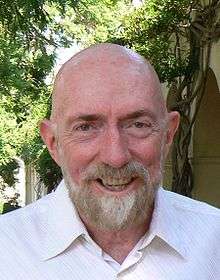 Nobel laureate Kip Thorne, BS 1962, known for his prolific contributions in gravitation physics and astrophysics and co-founding of LIGO
Nobel laureate Kip Thorne, BS 1962, known for his prolific contributions in gravitation physics and astrophysics and co-founding of LIGO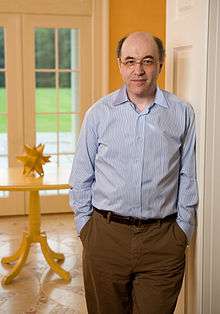 Stephen Wolfram, PhD 1979, creator of Mathematica and Wolfram Alpha; one of the first MacArthur Fellows in 1981
Stephen Wolfram, PhD 1979, creator of Mathematica and Wolfram Alpha; one of the first MacArthur Fellows in 1981 Stanislav Smirnov, PhD 1996, 2010 Fields Medal winner for his work on the mathematical foundations of statistical physics, particularly finite lattice models
Stanislav Smirnov, PhD 1996, 2010 Fields Medal winner for his work on the mathematical foundations of statistical physics, particularly finite lattice models France A. Córdova, PhD 1978, Astrophysicist and 14th Director of the National Science Foundation
France A. Córdova, PhD 1978, Astrophysicist and 14th Director of the National Science Foundation Nobel laureate Eric Betzig, BS 1983, known for his work on fluorescence microscopy and photoactivated localization microscopy
Nobel laureate Eric Betzig, BS 1983, known for his work on fluorescence microscopy and photoactivated localization microscopy
Faculty and staff

Richard Feynman was among the most well-known physicists associated with Caltech, having published the Feynman Lectures on Physics, an undergraduate physics text, and popular science texts such as Six Easy Pieces for the general audience. The promotion of physics made him a public figure of science, although his Nobel-winning work in quantum electrodynamics was already very established in the scientific community. Murray Gell-Mann, a Nobel-winning physicist, introduced a classification of hadrons and went on to postulate the existence of quarks, which is currently accepted as part of the Standard Model. Long-time Caltech President Robert Andrews Millikan was the first to calculate the charge of the electron with his well-known oil-drop experiment, while Richard Chace Tolman is remembered for his contributions to cosmology and statistical mechanics. 2004 Nobel Prize in Physics winner H. David Politzer is a current professor at Caltech, as is astrophysicist and author Kip Thorne and eminent mathematician Barry Simon. Linus Pauling pioneered quantum chemistry and molecular biology, and went on to discover the nature of the chemical bond in 1939. Seismologist Charles Richter, also an alumnus, developed the magnitude scale that bears his name, the Richter magnitude scale for measuring the power of earthquakes. One of the founders of the geochemistry department, Clair Patterson was the first to accurately determine the age of the Earth via lead:uranium ratio in meteorites. In engineering, Theodore von Kármán made many key advances in aerodynamics, notably his work on supersonic and hypersonic airflow characterization. A repeating pattern of swirling vortices is named after him, the von Kármán vortex street. Participants in von Kármán's GALCIT project included Frank Malina, who helped develop the WAC Corporal, which was the first U.S. rocket to reach the edge of space, Jack Parsons, a pioneer in the development of liquid and solid rocket fuels who designed the first castable composite-based rocket motor, and Qian Xuesen, who was dubbed the "Father of Chinese Rocketry". More recently, Michael Brown, a professor of planetary astronomy, discovered many trans-Neptunian objects, most notably the dwarf planet Eris, which prompted the International Astronomical Union to redefine the term "planet".
David Baltimore, the Robert A. Millikan Professor of Biology, and Alice Huang, Senior Faculty Associate in Biology, served as the presidents of AAAS from 2007–2008 and 2010–2011, respectively.[154]
33% of the faculty are members of the National Academy of Science or Engineering and/or fellows of the American Academy of Arts and Sciences. This is the highest percentage of any faculty in the country with the exception of the graduate institution Rockefeller University.[155]
The average salary for assistant professors at Caltech is $111,300, associate professors $121,300, and full professors $172,800.[156] Caltech faculty are active in applied physics, astronomy and astrophysics, biology, biochemistry, biological engineering, chemical engineering, computer science, geology, mechanical engineering and physics.[157]
Presidents
- James Augustin Brown Scherer (1908–1920) (president of Throop College of Technology before the name change)
- Robert A. Millikan (1921–1945), experimental physicist, Nobel laureate in physics for 1923 (his official title was "Chairman of the Executive Council")
- Lee A. DuBridge (1946–1969), experimental physicist (first to officially hold the title of President)
- Harold Brown (1969–1977), physicist and public servant (left Caltech to serve as United States Secretary of Defense in the administration of Jimmy Carter)
- Robert F. Christy (1977–1978), astrophysicist (acting president)
- Marvin L. Goldberger (1978–1987), theoretical physicist (left to serve as Director of Institute for Advanced Studies)
- Thomas E. Everhart (1987–1997), experimental physicist
- David Baltimore (1997–2006), molecular biologist, Nobel laureate in Physiology or Medicine for 1975
- Jean-Lou Chameau (2006–2013), civil engineer and educational administrator (left to serve as president of King Abdullah University of Science and Technology)
- Thomas F. Rosenbaum (2014–), condensed matter physicist and administrator
Caltech startups
Over the years Caltech has actively promoted the commercialization of technologies developed within its walls. Through its Office of Technology Transfer & Corporate Partnerships,[158] scientific breakthroughs have led to the transfer of numerous technologies in a wide variety of scientific-related fields such as photovoltaic, radio-frequency identification (RFID), semiconductors, hyperspectral imaging, electronic devices, protein design, solid state amplifiers and many more.[159] Companies such as Contour Energy Systems, Impinj, Fulcrum Microsystems, Nanosys, Inc., Photon etc., Xencor, and Wavestream Wireless[160] have emerged from Caltech.
In media and popular culture
Caltech has appeared in many works of popular culture, both as itself and in disguised form. On television, it plays a prominent role and is the workplace of all four male lead characters and one female lead character in the sitcom The Big Bang Theory. Caltech is also the inspiration, and frequent film location, for the California Institute of Science in Numb3rs.[161] On film, the Pacific Tech of The War of the Worlds[162] and Real Genius[161] is based on Caltech. In nonfiction, two 2007 documentaries examine aspects of Caltech: Curious, its researchers,[163][164] and Quantum Hoops, its men's basketball team.
Given its Los Angeles-area location, the grounds of the Institute are often host to short scenes in movies and television. The Athenaeum dining club appears in the Beverly Hills Cop series, The X-Files, True Romance, and The West Wing.[165]
References
- "THE CALTECH SEAL". California Institute of Technology. Archived from the original on April 8, 2015. Retrieved April 16, 2015.
- "Caltech: Did you know?". California Institute of Technology. Archived from the original on April 17, 2016. Retrieved December 26, 2013.
- As of June 30, 2019. "U.S. and Canadian 2019 NTSE Participating Institutions Listed by Fiscal Year 2019 Endowment Market Value, and Percentage Change in Market Value from FY18 to FY19 (Revised)". National Association of College and University Business Officers and TIAA. Retrieved April 21, 2020.
- "Caltech: At a Glance". California Institute of Technology. Archived from the original on December 22, 2015. Retrieved January 2, 2016.
- "Fall Enrollment 2019–20". Caltech – Office of the Registrar. Retrieved May 16, 2020.
- "Colors". Caltech Identity Toolkit. Archived from the original on January 19, 2018. Retrieved January 19, 2018.
- The university itself only spells its short form as "Caltech"; other spellings such as "Cal Tech" and "CalTech" are incorrect Archived April 12, 2012, at the Wayback Machine. The Institute is also occasionally referred to as "CIT", most notably in its alma mater, but this is uncommon.
- "Member Institutions". American Association of Universities. Archived from the original on August 10, 2012. Retrieved May 29, 2010.
- "Early History". NASA Jet Propulsion Laboratory. Archived from the original on October 26, 2011. Retrieved May 29, 2010.
- "Caltech Overview 2010–2011" (PDF). Caltech Office of Marketing and Communications. Archived from the original (PDF) on July 16, 2011. Retrieved March 8, 2011.
- Fitzpatrick, Laura (September 8, 2008). "The Biggest Pranks in Geek History". Time. Archived from the original on June 7, 2010. Retrieved May 30, 2010.
- "Baccalaureate Origins of Earned Doctoral Degrees (2003–2012)" (PDF). July 1, 2015. Archived from the original (PDF) on May 25, 2017. Retrieved May 12, 2016.
- Thomas, Grace Powers (1898). Where to educate, 1898–1899. A guide to the best private schools, higher institutions of learning, etc., in the United States. Boston: Brown and Company. p. 15. Archived from the original on October 17, 2012. Retrieved August 17, 2012.
- "Articles of Incorporation". Board of Trustees, California Institute of Technology. Archived from the original on March 7, 2010. Retrieved May 29, 2010.
- Goodstein, Judith R. (1991). "Preamble to a Technical School". Millikan's School: A History of the California Institute of Technology. New York, NY: W. W. Norton & Company. pp. 51–63. ISBN 0-393-03017-2.
- "Caltech Catalog" (PDF). Caltech. Archived from the original (PDF) on April 9, 2011. Retrieved May 28, 2011.
- Starr, Kevin (1997). "Unto the Stars Themselves, Astronomy and the Pasadena Perspective". The Dream Endures: California Enters the 1940s. Oxford: Oxford University Press. pp. 74–77. ISBN 0-19-515797-4. Archived from the original on December 3, 2019. Retrieved November 17, 2019.
- Goodstein, Judith R. (1991). "The Birth of Caltech". Millikan's School: A History of the California Institute of Technology. New York, NY: W. W. Norton & Company. pp. 64–75. ISBN 0-393-03017-2.
- Goodstein, Judith R. (1991). "The Birth of Caltech". Millikan's School: A History of the California Institute of Technology. New York: W. W. Norton & Company. pp. 71–75. ISBN 0-393-03017-2.
- "History of Caltech". Nobelprize.org. Archived from the original on August 4, 2010. Retrieved June 18, 2010.
- "Fast Facts about Caltech History". The Caltech Archives. Archived from the original on July 8, 2011. Retrieved March 8, 2011.
- "Oral History – Allen J. Acosta" (PDF). Pasadena, California: California Institute of Technology. April–May 1994. Archived (PDF) from the original on June 18, 2010. Retrieved September 29, 2011.
- "U.S. Naval Activities World War II by State". Patrick Clancey. Archived from the original on September 7, 2011. Retrieved March 19, 2012.
- "DuBridge, Lee A. "The President's Report." Engineering and Science 15.6 (1952): 9" (PDF). Archived (PDF) from the original on April 27, 2017. Retrieved April 27, 2017.
- Elliot, David C. (1986-01-01) "Project Vista and Nuclear Weapons in Europe." International Security. 11(1): 167.
- McCRAY, W. PATRICK, (2004-01-01) "Project Vista, Caltech, and the dilemmas of Lee DuBridge Historical Studies in the Physical and Biological Sciences. 34(2): 340.."
- "The 200-inch Hale Telescope". Caltech Astronomy. Archived from the original on July 18, 2010. Retrieved September 26, 2010.
- Gordon, Larry (August 6, 2007). "Caltech chemistry improves". Los Angeles Times. Archived from the original on May 8, 2010. Retrieved August 12, 2010.
- edu.ucla.library.specialCollections.latimes:3720 uclalat_1429_b609_238352 ark:/21198/zz0002vnsf
- "Caltech's Underground History" (PDF). Joe Antognini. Archived from the original (PDF) on July 19, 2011. Retrieved August 12, 2010.
- "Collected Papers of Albert Einstein". Archived from the original on November 9, 2004. Retrieved January 16, 2011.
- "Campaign Summary" (PDF). Archived from the original (PDF) on July 17, 2011. Retrieved January 16, 2011.
- "Joint Center for Artificial Photosynthesis". Archived from the original on October 20, 2010. Retrieved January 16, 2011.
- "Chameau to step down as president". Archived from the original on April 17, 2016. Retrieved February 19, 2013.
- "Caltech to Offer Online Courses through edX". Archived from the original on August 26, 2013. Retrieved September 16, 2013.
- Goldstein, Dana (September 26, 2019). "Caltech Gets a Windfall for Climate Research: $750 Million". The New York Times. Retrieved June 11, 2020.
- Halford, Bethany (September 27, 2019). "California Institute of Technology garners $750 million gift for sustainability research". Chemical & Engineering News. Retrieved June 11, 2020.
- Arnold Thackray & Minor Myers, Jr. (2000). Arnold O. Beckman : one hundred years of excellence. foreword by James D. Watson. Philadelphia, Pa.: Chemical Heritage Foundation. ISBN 978-0-941901-23-9.
- "Quantum leap: Caltech facility combines astronomy, astrophysics". AllBusiness. January 26, 2009. Archived from the original on September 9, 2010. Retrieved July 7, 2010.
- "Walter and Leonore Annenberg Center for Information Science and Technology". Caltech. August 10, 2009. Archived from the original on June 10, 2010. Retrieved July 7, 2010.
- "Caltech Cuts the Ribbon on Schlinger Laboratory". Caltech. March 9, 2010. Archived from the original on July 2, 2010. Retrieved July 7, 2010.
- "Perpetual Energy Systems Activates 1.1 MW Solar Energy System at California Institute of Technology". Business Wire. October 21, 2010. Archived from the original on October 24, 2010. Retrieved October 22, 2010.
- "Bylaws". Board of Trustees, California Institute of Technology. June 12, 2009. Archived from the original on April 18, 2009. Retrieved May 29, 2010.
- "Dr. Jean-Lou Chameau, President". California Institute of Technology. Archived from the original on May 27, 2010. Retrieved May 29, 2010.
- "Executive Compensation". The Chronicle of Higher Education. 2010. Archived from the original on October 14, 2012. Retrieved March 8, 2011.
- "Faculty Handbook". California Institute of Technology. Archived from the original on June 7, 2010. Retrieved May 30, 2010.
- "2008 Annual Report" (PDF). Jet Propulsion Laboratory. Archived from the original (PDF) on August 25, 2009. Retrieved May 30, 2010.
- "Officers of the Corporation Trustees". Board of Trustees, California Institute of Technology. June 12, 2009. Archived from the original on April 17, 2009. Retrieved May 29, 2010.
- "Carnegie Classifications – California Institute of Technology". Carnegie Foundation for the Advancement of Teaching. Archived from the original on September 13, 2018. Retrieved September 12, 2018.
- "Accreditation". California Institute of Technology. Archived from the original on May 30, 2010. Retrieved May 29, 2010.
- "Statement of Accreditation Status – California Institute of Technology". Western Association of Schools and Colleges. April 2010. Archived from the original on September 16, 2009. Retrieved May 29, 2009.
- "Common Data Set 2012–2013" (PDF). Office of Budget & Planning, California Institute of Technology. Archived (PDF) from the original on May 13, 2014. Retrieved May 17, 2013.
- "Caltech Today Calendary". California Institute of Technology. Archived from the original on July 23, 2012. Retrieved May 30, 2010.
- "Academic Ranking of World Universities 2020: National/Regional Rank". Shanghai Ranking Consultancy. Retrieved August 15, 2020.
- "America's Top Colleges 2019". Forbes. Retrieved August 15, 2019.
- "U.S. College Rankings 2020". Wall Street Journal/Times Higher Education. Retrieved September 26, 2019.
- "Best Colleges 2020: National University Rankings". U.S. News & World Report. Retrieved September 8, 2019.
- "2019 National University Rankings". Washington Monthly. Retrieved August 20, 2019.
- "Academic Ranking of World Universities 2020". Shanghai Ranking Consultancy. 2020. Retrieved August 15, 2020.
- "QS World University Rankings® 2021". Quacquarelli Symonds Limited. 2020. Retrieved June 10, 2020.
- "World University Rankings 2020". THE Education Ltd. Retrieved September 14, 2019.
- "Best Global Universities Rankings: 2020". U.S. News & World Report LP. Retrieved October 22, 2019.
- "California Institute of Technology – U.S. News Best Grad School Rankings". U.S. News & World Report. Archived from the original on December 13, 2018. Retrieved November 12, 2019.
- "California Institute of Technology – U.S. News Best Global University Rankings". U.S. News & World Report. Archived from the original on November 12, 2019. Retrieved November 12, 2019.
- "California Institute of Technology Rankings". U.S. News & World Report. 2020. Archived from the original on December 14, 2018. Retrieved September 11, 2019.
- "CalTech's Graduate School Rankings". U.S. News & World Report. 2020. Archived from the original on July 15, 2017. Retrieved June 2, 2017.
- "Times Higher Education World University Rankings". Times Higher Education. 2011. Archived from the original on December 12, 2011. Retrieved January 21, 2012.
- "Times Higher Education World University Rankings – Top 50 Engineering and Technology Universities". Times Higher Education. 2011. Archived from the original on January 20, 2012. Retrieved January 21, 2012.
- "Times Higher Education World University Rankings – Top 50 Physical Sciences Universities". Times Higher Education. 2011. Archived from the original on January 18, 2012. Retrieved January 21, 2012.
- "QS World University Rankings 2010 – Citations per Faculty". QS World Universities. 2010. Archived from the original on September 11, 2010. Retrieved September 9, 2010.
- "Class Profile - www.admissions.caltech.edu". www.admissions.caltech.edu. Archived from the original on October 22, 2017. Retrieved October 21, 2017.
- "The 22 colleges that have students with the highest SAT scores". Archived from the original on October 21, 2017. Retrieved October 21, 2017.
- "Caltech Undergraduate Admissions: Costs". California Institute of Technology. Archived from the original on May 10, 2013. Retrieved May 17, 2013.
- "Caltech Undergraduate Admissions: Options of Study". California Institute of Technology. Archived from the original on February 5, 2007. Retrieved May 30, 2010.
- "Office of the Registrar Newsletter". Caltech Office of the Registrar. 2010. Archived from the original on July 17, 2011. Retrieved December 15, 2010.
- "Caltech Catalog 2012–13, Section Three (Information for Undergraduate Students)" (PDF). California Institute of Technology. Archived (PDF) from the original on April 4, 2019. Retrieved April 16, 2019.
- "Caltech Undergraduate Admissions: Core Curriculum". California Institute of Technology. Archived from the original on October 2, 2018. Retrieved April 16, 2019.
- Hall, John D.; Green, Barbara C. (October 2009). "Information for Freshman Advisors, 2009–2010" (PDF). California Institute of Technology. Archived from the original (PDF) on June 28, 2010. Retrieved May 30, 2010.
- "Caltech Undergraduate Admissions: FAQ". California Institute of Technology. Archived from the original on June 6, 2010. Retrieved June 1, 2010.
- "Caltech Undergraduate Admissions: Honor Code". California Institute of Technology. Archived from the original on May 27, 2010. Retrieved June 1, 2010.
- "Top US Colleges – Graduate Salary Statistics". PayScale. Archived from the original on July 24, 2009. Retrieved May 17, 2013.
- "Colleges Worth Your Investment – Full List". PayScale. Archived from the original on January 18, 2012. Retrieved May 17, 2013.
- "Application Instructions – Required Tests" (PDF). Caltech. Archived (PDF) from the original on October 9, 2019. Retrieved September 25, 2019.
- "MD/PhD Program – Keck School of Medicine of USC". Archived from the original on August 7, 2016. Retrieved July 31, 2016.
- "UCLA Caltech Medical Science Training Program". Archived from the original on April 6, 2013.
- "Research Facilities". Caltech. Archived from the original on November 2, 2010. Retrieved October 25, 2010.
- "Faculty". Caltech. Archived from the original on October 21, 2010. Retrieved October 25, 2010.
- "Financial Support". Caltech. Archived from the original on September 28, 2010. Retrieved October 25, 2010.
- "Carnegie Classifications - Institution Profile". Indiana University Center for Postsecondary Research. Retrieved March 30, 2020.
- Funding for Caltech does not include NASA's funding for JPL.
- "R&D expenditures at universities and colleges, ranked by FY 2008 R&D expenditures: FY 2001–08" (PDF). National Science Foundation. April 2010. Archived from the original (PDF) on January 10, 2011. Retrieved May 29, 2010.
- "R&D expenditures at all universities and colleges without a medical school, ranked by all R&D expenditures, by source of funds: FY 2008" (PDF). National Science Foundation. April 2010. Archived from the original (PDF) on January 10, 2011. Retrieved May 29, 2010.
- "Federally financed R&D expenditures at universities and colleges reporting federal agency detail, ranked by all federal R&D expenditures, by federal agency:FY 2008" (PDF). National Science Foundation. April 2010. Archived from the original (PDF) on January 10, 2011. Retrieved May 29, 2010.
- "Federally financed R&D expenditures at universities and colleges reporting federal agency detail, ranked by all federal R&D expenditures, by science and engineering field: FY 2008" (PDF). National Science Foundation. April 2010. Archived from the original (PDF) on January 10, 2011. Retrieved May 29, 2010.
- "Annual Report 2008-2009". California Institute of Technology. April 2010. Archived from the original on May 12, 2010. Retrieved May 28, 2010.
- "Mathematical & Physical Sciences (MPS) Active Awards". National Science Foundation. Archived from the original on October 16, 2011. Retrieved October 23, 2011.
- "Science and engineering research space in academic institutions, by state, control, institution, and field: FY 2005" (PDF). National Science Foundation. 2005. Archived from the original (PDF) on June 6, 2011. Retrieved May 29, 2010.
- "Kavli Nanoscience Institute (website)". California Institute of Technology. Archived from the original on June 19, 2010. Retrieved May 30, 2010.
- "SURF Annual Report 2010" (PDF). Caltech. Archived (PDF) from the original on July 19, 2011. Retrieved March 8, 2011.
- National Science Foundation. "nsf.gov – NCSES Baccalaureate Origins of S&E Doctorate Recipients – US National Science Foundation (NSF)". Archived from the original on July 4, 2015. Retrieved July 3, 2015.
- "Home - www.innovation.caltech.edu". Archived from the original on July 11, 2016. Retrieved July 3, 2015.
- "U.S. Colleges and Universities- Utility Patent Grants, Calendar Years 1969–2008". U.S. Patent and Trademark Office. Archived from the original on October 18, 2011. Retrieved January 31, 2011.
- "Bechtel Residence | Design and Construction". dandc.caltech.edu. Archived from the original on November 12, 2019. Retrieved November 12, 2019.
- "Caltech Undergraduate Housing". California Institute of Technology. Retrieved April 28, 2020.
- Caltech Athletics Archived January 10, 2007, at the Wayback Machine. Retrieved November 19, 2007.
- "About Caltech". Athletics.caltech.edu. Archived from the original on April 17, 2016. Retrieved October 10, 2015.
- Southern California Intercollegiate Athletic Conference Archived August 11, 2007, at the Wayback Machine. Retrieved November 19, 2007.
- "Caltech Athletics — Fencing Team". Athletics.caltech.edu. Archived from the original on September 4, 2004. Retrieved October 13, 2009.
- Associated Press (January 7, 2007). "Caltech crushes Bard College to end 207-game slide". ESPN. Archived from the original on January 16, 2010. Retrieved November 19, 2007.
- Branch, John (February 23, 2011). "Caltech Scores First Conference Victory Since 1985". The New York Times. Archived from the original on March 3, 2011. Retrieved February 23, 2011.
- Branch, John (December 15, 2010). "Sky-High SATs, but the Team's at Rock Bottom". The New York Times. Archived from the original on December 16, 2010. Retrieved December 17, 2010.
- "Caltech Athletics". Athletics.caltech.edu. Archived from the original on June 28, 2008. Retrieved October 13, 2009.
- "Pomona-Pitzer College vs Caltech (01–13–07 at Caltech Braun Center)". January 13, 2007. Archived from the original on December 23, 2007. Retrieved November 19, 2007.
- "2007 Women's Basketball All-SCIAC Awards". March 7, 2007. Archived from the original on October 27, 2007. Retrieved November 19, 2007.
- College Women's Top UPA Rankings Archived August 4, 2007, at the Wayback Machine, Ultimate Player's Association. Retrieved November 19, 2007.
- "Caltech baseball team ends 228-game skid". ajc.com. Archived from the original on February 6, 2013. Retrieved February 3, 2013.
- "Caltech Glee Clubs". Archived from the original on June 4, 2016. Retrieved May 13, 2016.
- Hiszpanski, Anna (April 3, 2006). "Fleming Cannon Gone" (PDF). The California Tech. 107 (21). p. 3. Archived (PDF) from the original on April 19, 2014. Retrieved April 17, 2014.
- "Comedy on campus: MIT takes on Caltech for prank distinction". The Boston Globe. April 19, 2006. Archived from the original on February 5, 2007. Retrieved November 19, 2007.
- California Pulls Portal Prank on New York Archived January 10, 2012, at the Wayback Machine. Kotaku.com. Retrieved on 2013-07-21.
- Caltech Opens Humanities School at MIT Campus Archived December 2, 2009, at the Wayback Machine, December 6, 2009
- Citybeats: Future Tournament of Roses chief vows even better parades Archived December 12, 2009, at the Wayback Machine, Pasadena Star-News, December 6, 2009
- What's (Literally) Up with the TARDIS? Archived January 10, 2011, at the Wayback Machine, Caltech Features, January 6, 2011
- Dr. Who's TARDIS Lands at MIT, Caltech, and Berkeley Archived April 20, 2011, at the Wayback Machine, by Alessondra Springmann, PCWorld, February 10, 2011
- TARDIS on building 7, great dome, and beyond Archived April 23, 2011, at the Wayback Machine, IHTFP Hack Gallery, April 25, 2011
- "CatalogProductITems – Caltech Bookstore". Archived from the original on September 30, 2018. Retrieved July 3, 2015.
- "The Honor System Handbook from the Board of Control at Caltech.edu". Donut.caltech.edu. Archived from the original on November 6, 2009. Retrieved October 13, 2009.
- "Graduate Studies Office – The Honor Code". www.gradoffice.caltech.edu. Archived from the original on April 8, 2013. Retrieved March 29, 2013.
- Rodriguez, Juan (February 24, 2003). "Ricketts Pres. Apologizes". The California Tech. p. 5.
- "An open letter from concerned alumni & More" (PDF). The California Tech. November 17, 2011. pp. 2–4, 6–8.
- Mic. "Caltech's Shocking Lack of Diversity: A Microcosm for the United States?". Mic. Archived from the original on March 17, 2017. Retrieved March 16, 2017.
- "Best Colleges: Highest graduation rates". U.S. News & World Report. Archived from the original on June 5, 2010. Retrieved May 28, 2010.
- "Universities: Caltech & M.I.T.: Rivalry Between the Best". Time. November 4, 1966. Archived from the original on July 1, 2010. Retrieved May 28, 2010.
- "Degrees of Success: Bachelor's Degree Completion Rates among Initial STEM Majors" (PDF). Higher Education Research Institute, University of California, Los Angeles. January 2010. Archived from the original (PDF) on March 7, 2010.
- "Caltech at a Glance". California Institute of Technology. Archived from the original on July 25, 2016. Retrieved May 23, 2016.
- Cipra, Barry Arthur (August 19, 2010). "Fields Medals, Other Top Math Prizes, Awarded". Science Now. American Association for the Advancement of Science. Archived from the original on August 22, 2010. Retrieved August 19, 2010.
- Deborah Lee Soltesz. "USGS Astrogeology: Astronaut Harrison H. Schmitt". United States Geological Survey – Astrogeology Program. Archived from the original on October 17, 2011. Retrieved August 28, 2017.
- "In 1998, Celestis, at the request of NASA, provided a Luna Flight Capsule to the family and friends of the astronomer and planetary geologist Eugene Shoemaker. The Celestis Flight Capsule, containing a symbolic portion of Shoemaker's cremated remains, was attached to NASA's Lunar Prospector spacecraft and launched on a one-year mission orbiting the moon. On July 31, 1999, at the completion of Lunar Prospector's mission, the spacecraft was intentionally crashed into the moon's south pole, making Shoemaker the first human to be laid to rest on another celestial body. NASA called the memorial "a special honor for a special human being.""Clara Moskowitz (March 28, 2008). "Fly Me to the Moon ... Forever". Space.com. Archived from the original on August 2, 2010. Retrieved May 7, 2010.
- "George O. Abell, Astronomy: Los Angeles". calisphere. University of California. Archived from the original on October 1, 2018. Retrieved April 9, 2017.
- York Liao (BS 1967)Caltech News (1997). "Caltech Alumni Album Profiles '50s, '60s, '70s and '80s – York Liao '67". California Institute of Technology. Archived from the original on June 4, 2010. Retrieved May 7, 2010.
- Sabeer Bhatia, BS 1991Caltech Media Relations (July 18, 2008). "SURFing the Waves of Success for 30 Years". California Institute of Technology. Archived from the original on June 2, 2010.
- Benjamin Rosen, BS 1954Caltech Alumni Association. "Distinguished Alumni Award – Benjamin M. Rosen". Caltech Alumni Association. Archived from the original on July 16, 2011. Retrieved May 7, 2010.
- Cleve Moler, BS 1961 "Cleve Moler Elected Next SIAM President". Society for Industrial and Applied Mathematics. December 16, 2005. Archived from the original on January 17, 2015. Retrieved May 7, 2010.
- Gordon Moore, PhD 1954Caltech Alumni Association. "Distinguished Alumni Award – Gordon E. Moore". Caltech Alumni Association. Archived from the original on July 16, 2011. Retrieved May 7, 2010.
- Simon Ramo, PhD 1936 Caltech Public Relations (February 24, 2010). "The Singular Si Ramo". Caltech Today (via California Institute of Technology). Archived from the original on September 28, 2011. Retrieved May 7, 2010.
- Frank Oppenheimer, PhD 1939 Caltech Alumni Association. "Frank Oppenheimer". Caltech Alumni Association. Archived from the original on July 16, 2011. Retrieved May 7, 2010.
- The Nobel Foundation (1956). "William B. Shockley – Biography". The Nobel Prize Committee (official site). Archived from the original on February 26, 2010. Retrieved May 7, 2010.
- Bill Roberts (November 1, 2005). "The Ten Most Influential Executives". EDN. Archived from the original on January 27, 2007.
- "How he was miserable is more complicated than even I could get into a hundred thousand word book. There was something wrong with him. What was wrong with him, we don't really know. He was at best paranoid. He was probably obsessive-compulsive. The manuscript of the book has been shown to about six or seven psychotherapist, and I asked them for a diagnosis, and they came back with six or seven different diagnoses." Ira Flatow (interview) with journalist Joel Shurkin (July 21, 2006). "Electronics Pioneer William Shockley's Legacy". National Public Radio. Archived from the original on August 18, 2018. Retrieved April 5, 2018.
- "Shockley, whose role as coinventor of the transistor would win him a share of the 1956 Nobel Prize in physics, succeeded in luring a diverse group of accomplished scientists, including Moore, to the Shockley Semiconductor Laboratory, in Palo Alto, California. He then proceeded to antagonize and alienate enough of them to inspire an exodus."Hillary Bhaskaran (2002). "Calibrating Gordon Moore". Caltech News. Archived from the original on October 25, 2010. Retrieved May 7, 2010.
- "Joel Shurnkin: ... He decided he was going to be the first entrepreneur of the electronic age, and indeed he was. With backing from a man named Arnold Beckman, he founded Shockley Semiconductor in Palo Alto and he was going to build – at least at first he was going to build silicon transistors. It was his decision that they use silicon as opposed to germanium, otherwise we'd be talking about Germanium Valley out there instead of Silicon Valley. (Soundbite of laughter) "Ira Flatow (interview) with journalist Joel Shurkin (July 21, 2006). "Electronics Pioneer William Shockley's Legacy – Transcript". National Public Radio. Archived from the original on August 18, 2018. Retrieved April 5, 2018.
- "Ellen Williams (PhD '82) Nominated as Director of the Advanced Research Projects Agency-Energy". Caltech Alumni Association. Archived from the original on November 10, 2013.
- "Distinguished Alumni Award – Frank Capra". California Institute of Technology. Archived from the original on July 19, 2011. Retrieved May 7, 2010.
- "AAAS Presidents". AAAS. 2011. Archived from the original on July 24, 2011. Retrieved January 12, 2011.
- "Faculty". Caltech. 2010. Archived from the original on July 16, 2011. Retrieved January 2, 2011.
- "AAUP Faculty Salary Survey". The Chronicle of Higher Education. 2012. Archived from the original on April 10, 2012. Retrieved April 9, 2012.
- "Faculty Scholarly Productivity Index – California Institute of Technology". The Chronicle of Higher Education. 2007. Archived from the original on June 11, 2011. Retrieved May 30, 2010.
- "Office of Technology Transfer & Corporate Partnerships". Archived from the original on November 18, 2018. Retrieved November 18, 2018.
- "University Spinoffs". University Spinoffs. Archived from the original on May 7, 2010.
- "OTTCP's Startups Map". Archived from the original on January 6, 2015.
- Caltech References in "Real Genius" Archived May 10, 2013, at the Wayback Machine. Retrieved 2007-11-19.
- Cowan, Douglas E. "Intellects vast and cool and unsympathetic: Science, Religion, and The War of the Worlds Archived May 17, 2009, at the Wayback Machine." Journal of Religion and Film, Vol. 11, No. 1, 1 April 2007.
- ""CURIOUS" from Thirteen/WNET". Thirteen.org. Archived from the original on October 5, 2009. Retrieved October 13, 2009.
- "Documentary Focuses on Caltech Researchers" Archived November 1, 2007, at the Wayback Machine Caltech Press Release, 1 October 2007
- "Film locations for Beverly Hills Cop". Movie-locations.com. Archived from the original on January 3, 2010. Retrieved October 13, 2009.
External links
| Wikimedia Commons has media related to Caltech. |
| Wikiquote has quotations related to: California Institute of Technology |

